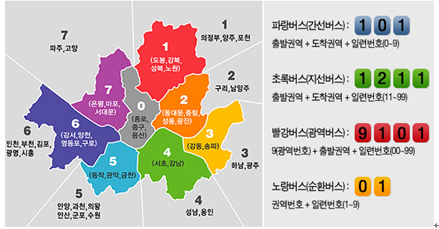TOPIS: Seoul’s Intelligent Traffic System (ITS)
Policy Overview
“An emergency on the city's roads automatically triggers an alarm system and informs all of the parties concerned including police stations, bus operators, and the general public. The real-time on-site information obtained through surveillance cameras enables a swift response.”
The Transport Operation and Information Service (TOPIS) of the Seoul Metropolitan Government, the "control tower" of Seoul City’s comprehensive transportation system, makes all this possible. It gathers and processes the city’s road traffic and subway train information in real time to enable the city to efficiently manage the intervals between buses, relieve congestion, and take timely action in the event of an accident.
Background Information
- Mounting challenges facing the pre-existing transportation system
- Need for an integrated information system seamlessly linking demand for diverse means of transportation
- Absence of a system capable of consolidating and managing transportation information
Goals and Objectives
- Real-time information sharing and management of bus operations to enhance user convenience and attract more passengers to take public transport.
- Collection of traffic information to help alleviate road congestion and respond more quickly and efficiently to unexpected situations.
- Analysis of the accumulated information with the aim of devising scientific public transportation policies.
Implementation and Expertise
-Real-time monitoring of traffic and information
< Average No. of cases reported per day >
| Case | Roadworks | Accidents | Rallies | Total |
| No. of cases of road traffic information provision | 9 | 43 | 1 | 53 |
- BMS, a Bus Management System for more scientific operation of intra-city buses
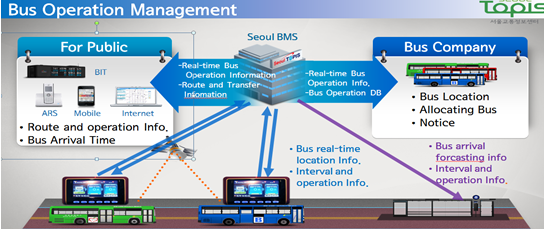
- Real-time information on public transportation operation (subway, bus)
Citizens now benefit from real-time traffic information on arrival times on bus routes and at bus stops, and subway operations via various means including the Internet, mobile devices, BIT, and QR code. As the city even allows private developers to utilize the information, the service has become truly ubiquitous.
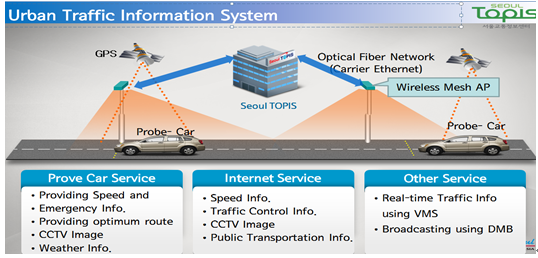
- Complete reform of the bus numbering system
To ensure the consistent management of traffic information, a bus with a particular number was expected to operate on a given route. However, in Seoul, the numbers were allocated as requested by the bus companies, causing the system to be less organized and confusing. As such, users found it difficult to trace the linkages between old numbers and new ones whenever a route was eliminated or newly created. To resolve this issue, the Seoul Metropolitan Government implemented restructuring of the bus numbers by which a bus number indicates the driving direction, enabling users to easily match the stops and destinations. Buses are now classified into trunk, feeder, inter-regional, and circular lines, and are color-coded blue, green, red, and yellow respectively.
< The principles of bus numbering >
- Evolution from TOPIS 1.0 to TOPIS 3.0
The Traffic Operation Information System has evolved from the era of ‘cutting-edge’ (TOPIS 1.0) to ‘openness’ (TOPIS 2.0), through to the current era of ‘collaboration’ (TOPIS 3.0). It is now seeking to share its know-how with foreign cities, along with private tech companies, while bracing itself for future transportation needs such as traffic forecasting systems using big data.
Limitations and solutions
- Fierce opposition from interested parties such as bus companies and street vendors
While setting up the TOPIS, the Seoul Metropolitan Government also introduced the exclusive median bus lane system and executed the Quasi-public Bus Operation project. In particular, the adoption of median bus lanes was inevitable to ensure punctuality and even intervals. Despite its good intentions, however, the city faced strong resistance from various interested parties including bus companies that were opposed to the quasi-public operation of bus services, and street vendors who were against the idea of moving bus lanes from the roadside to the central lanes.
Solution: Active promotion to citizens and consultation with the affected parties
Faced with stiff resistance from street vendors, the Seoul Metropolitan Government tried to bring them around to its view through continuous discussions. Along with the bus association, it organized workshops for the reform of Seoul’s bus operation system, where it coordinated conflicting views and guaranteed management rights and reasonable compensation respectively to bus companies and street vendors. As a result, it was able to establish a consensus among them after multiple rounds of negotiations.
- Lack of cooperation between the related agencies
Building a framework for information-sharing and smooth cooperation among all the relevant parties was not easy, and thus there were constraints on encouraging their active participation.
Solution: To build a consensus through continuous discussion
Faced with these obstacles, the city continued its discussions with all the interested parties including police stations, fire stations, military bases and nearby local governments in an effort to establish a consensus on the need to build an integrated transportation management system.
Resources
- Budget: Approximately KRW 200 billion
As the city was the country’s first local government to develop such an intelligent transportation system (ITS), the project - which began in 1998 - was entirely financed by the municipal budget, without any support at all from the central government. However, the benefits of the system soon became known to other local governments, and the central government came to recognize its necessity, so some of the city’s additional projects are now subsidized by the state on a 50-50 basis.
- Human resources
During the initial stage of the project, a total of twenty-nine professionals in various fields planned and developed the system. As for on-site facility management and maintenance of such installations as electronic road signs, it has been outsourced or consigned to private enterprises.
< Staffing for TOPIS (2008)>
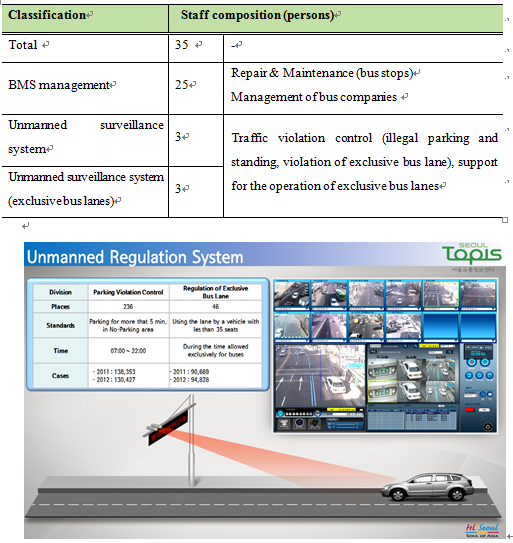
- Revision of the laws and regulations
The ITS is based on the National Transport System Efficiency Act, and the city continued to ask for the revision of the Act and succeeded in ensuring that the ITS project was eligible for state subsidies in 2008.
Results and evaluation
- Bus users: Rising customer satisfaction
Users’ satisfaction with the bus service has risen due to the provision of real-time bus operation information. They awarded high marks to the service quality improvement as they became more comfortable with the regular intervals and safer driving, and the fact that they no longer had to wait very long thanks to the provision of accurate arrival time information.
< User Satisfaction with Public Transport Information (99.8%)>
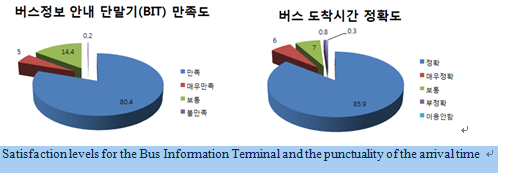
- Bus companies: The growing number of passengers boosts profitability
The regular intervals and predictable arrival times have attracted more passengers to take buses, and there are now fewer accidents due to the greater control over drivers' speeding and aggressive driving, resulting in shrinking insurance premiums and greater profitability. Above all, the bus companies are now able to regulate illegal operations, such as bus drivers passing by a bus stop without stopping, and the service quality has been boosted as well.
- Seoul Metropolitan Government: reinvigoration of public transportation
With bus operations becoming more convenient and easily accessible, the city has regained the public’s trust. The application of advanced science and technology to the system has reinforced its management in terms of accuracy, objectivity and profitability. The running of the exclusive median bus lane system in parallel with the new system has also contributed to the improved punctuality of intra-bus operation, while the city’s efforts to take swift action against illegal operations have encouraged drivers to comply with the regulations.
Applicability
- Support for private tech companies’ efforts to expand abroad
The municipal government is sparing no effort to support the related businesses in exporting their intelligent transport management technologies. As the city annually receives as many as 1,300 foreign officials each year, it has built the ITS-Friendship which enables Korean ITS firms to connect and socialize with officials from foreign cities.
- Standardization of the ITS
Utilizing its wealth of technology and experience, Seoul plans to develop a standard platform for an intelligent transport system and apply it to other domestic governments as well as share it with foreign cities. The adoption of a standard platform will help many foreign cities to introduce the ITS without a heavy initial investment, even though they might lack the necessary skills and experience.
International Awards
- 2011: Recipient of the PTx2 Showcase Award at the 59 UIPT
- 2013: Recipient of the Local Government Award
TOPIS English brochure
Overview (updated)
Seoul TOPIS (Seoul Transport Operation & Information Service) is an integrated traffic management center that operates and manages Seoul’s traffic situation and collects traffic information from traffic-related systems and organizations, including the Bus Management System (BS), traffic card system, unmanned enforcement systems and traffic broadcasting, the National Policy Agency, and the Korea Expressway Corporation.
“Seoul TOPIS” (Seoul Transport Operation and Information Services) refers to an integrated traffic center that plans, constructs, and operates Seoul’s Intelligent Transport System (ITS). The Korean name can be literally translated as ‘Seoul Traffic Information Center.’ However, the English name of Seoul TOPIS is more familiar to the public. The traffic information situation control room, which is an important part of Seoul TOPIS, is sometimes easily mistaken for the entire Seoul TOPIS. However, Seoul TOPIS actually refers to the intangible functional organization that manages Seoul City’s ITS, which applies advanced IT to traffic, as a practical department of Seoul City composed of four divisions and 90 employees. During its evolution over the past 15 years, Seoul TOPIS has come to acquire diverse functions and equipment. In 2015, the functions of Seoul TOPIS were systematized in order to launch a new platform. Its components include the six platforms of the central platform (traffic information control room), the bus platform (BIS/BS), the unmanned enforcement platform, the freeway traffic management system (FTMS), the advanced traffic management system (ATMS), and the big data platform (traffic predictions, information support).
Seoul TOPIS collects a wide array of traffic information on a continuous basis, including information on highways and freeways, 9,000 buses, current traffic situations from public traffic card systems, vehicle violations (illegal parking and stopping, speeding, driving in bus lanes), and accidents. Then, based on this information, it analyzes traffic demand or the causes of traffic congestion and provides the real-time traffic information required by traffic facility users and public transportation operation managers. With respect to unmanned enforcement, it comprises an automatic penalty management system that collectively manages the imposition and collection of penalties and fines.
With the use of advanced IT, detailed information on Seoul’s massive traffic system can be collected in real time, and a remarkable corpus of data can be gathered and analyzed by just the one center of Seoul TOPIS. All this is carried out in order to increase the accuracy of the information. Furthermore, by sharing the results of traffic analyses with private corporations and the public, it facilitates the development of various derived information products. Ultimately, Seoul TOPIS works toward the goal of constructing a traffic system that maximizes user satisfaction and enhances the safety of traffic users, as well as minimizing traffic congestion by optimizing the efficiency of existing traffic facilities.
Figure 1: Seoul TOPIS Platform
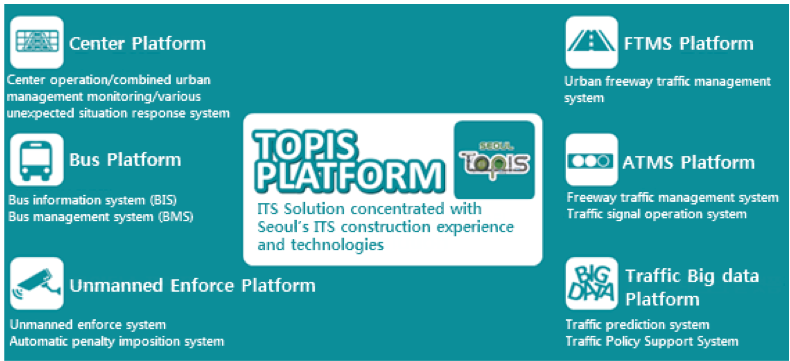
Source: Seoul Traffic Information Division (2016)
Policy Implementation Period
- 1998: Institution of the Namsan region traffic management system (10.6km)
- 2000: Institution and expansion of the urban highway traffic management system
- 2004: Inauguration of Seoul TOPIS (situation control room) and introduction of the traffic card system
- 2005: Introduction of the unmanned enforcement system
- 2008: Pilot installation and expansion of the bus information terminal (BIT)
- 2009: Launch of the mobile traffic information service
- 2010: Opening of public access to traffic data
- 2013: Introduction of Standard design (VMS, VDS) of the ITS facility
- 2013: Launch of the combined (traffic + disaster + general affairs) urban management situation control room
- 2014: Launch of the Seoul TOPIS platform (ITS Solution)
Figure 2: History of Seoul TOPIS
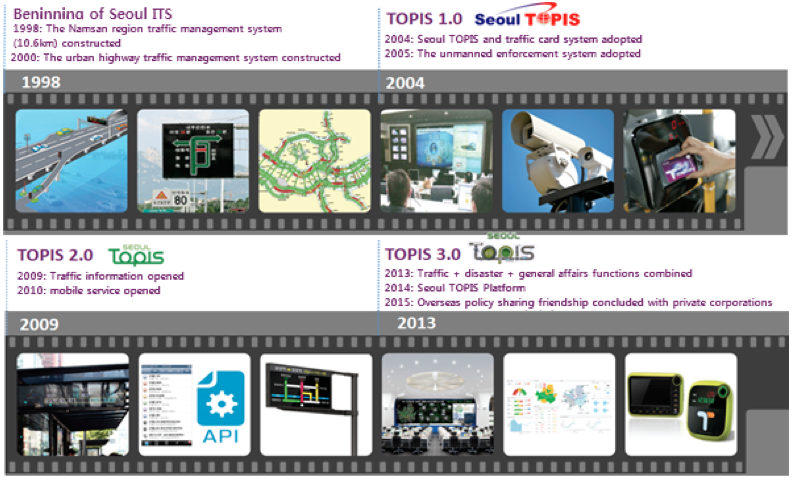
Source: Seoul Traffic Information Division (2016)
Background Information Before 2004
In the 1950s and ’60s, before Korea’s economic development had officially begun, Seoul’s traffic facilities and infrastructure were very weak. Even catching a bus was difficult, and the roads had no traffic signals, resulting in the dependence on hand signals. The ‘surface car’ (also known as the streetcar or tram) constructed in the early twentieth century was basically the only available form of public transport. In addition to the expansion of the city, the route network was gradually extended. However, there were difficulties in handling the ever increasing number of users resulting from rapid economic growth. In addition, with the remarkable increase in the use of motor vehicles and the introduction of buses, which allowed freer movement, the surface car - whose installation and expansion were relatively difficult - inevitably began to decline, resulting in the closure of the last route in 1968.
At the time of the discontinuation of the surface car, Seoul’s public transportation consisted solely of surface cars and buses, each of which transported around half of the city’s population. The official growth of Seoul began at this time, and the city began to section and compartmentalize itself by gradually constructing roads from the nearest regions into the heart of the city, using buses as the main form of transportation.
Throughout the era of rapid urban growth that followed the 1970s, roads were built in order to expand the bus services, and the infrastructure of Seoul’s road system was formed by constructing the Gangbyeonbuk-ro and Hangang bridges as a means of expanding the weak traffic facilities. Furthermore, in 1974, a new era of transport in Seoul was ushered in with the opening of Seoul Subway Line number 1.
However, the consistently rising income of Seoul’s citizens occasioned by rapid industrialization resulted in a surge in the use of vehicles. The increase in road transport facilities inevitably led to further increases in the use of private vehicles, and this in turn resulted in a shortage of roads. At the time, therefore, there was seemingly no practical solution to the chronic road congestion.
In a situation where the general role of public transportation was decreasing in line with the ever increasing use of private vehicles, the status of the subway system rose - compared with that of buses - in the public transportation market in the early 2000s, which was not unrelated to the institutional support for establishing the subway as the main axis of Seoul’s transportation system. However, due to the excessive use of private vehicles, the level of road services declined, and the service competitiveness of buses, which depend on the same roads, weakened in relative terms. This in turn caused an outflow of users to other modes of transport, and the allocated rate of bus passengers fell from 30.1% in 1996 to 26% in 2002 (Seoul Statistics 2016).
Figure 3: 1980-2002 Trends of Allocated Passengers for each Method of Transportation
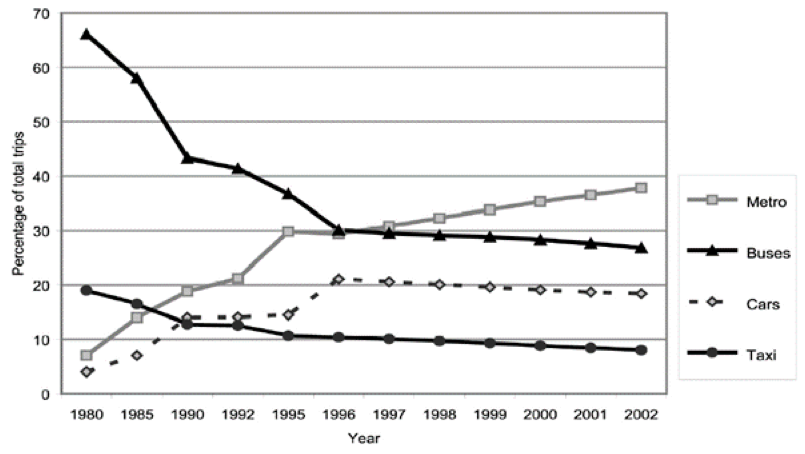
Source: Seoul City 2004; The Seoul Institute 2003
After 2004
Together with the notion that building more roads would not resolve traffic problems, particularly the problem of traffic congestion, the general public came to view the role of public transportation as ever more important, while Seoul City recognized the need to revitalize the visibly declining bus industry. Although the city made several attempts to partially improve the bus service, the public transportation system was not comprehensively reformed until 2004.
The two essential elements of these reforms were as follows:
1) The public transportation service was unified by combining the subway and bus systems in order to reinforce the competitiveness of public transportation.
2) Although the bus industry was run by the private sector at that time, a so-called semipublic bus management system was established to control the market price in the areas of operations and management. This was considered absolutely essential to meet the strategic goal of combining the various modes of public transportation.
In order to secure the competitiveness of public transportation, the quality of the city’s public transportation services had to be improved considerably. The central bus lane, smart traffic card, and the public transportation information system (BMS/BIS) were introduced as elements of the reformation of the public transportation system, which all encompasses Seoul TOPIS.
The Importance of the Policy
Relevance with Other Policies
As seen in the platform composition of Seoul TOPIS, each of the following policies - which were provided as a part of the current manual series - is a platform that handles the operation of the real-time traffic system of Seoul TOPIS.
1) Bus information system (BMS/BIS)
2) Unmanned enforcement system
3) Freeway Traffic Management System (FTMS)
4) Advanced Traffic Management System (ATMS)
Policy Objectives
The goal is to provide a forum for sharing an advanced traffic system and public transportation operation management and, consequently, to provide scientific traffic administrative support, real-time communication management and citizen traffic information services by connecting and combining traffic information and traffic systems.
The following specific goals will be achieved by optimizing the efficiency of existing traffic facilities, including roads.
1) Improvement of urban traffic speeds by minimizing traffic congestion.
2) To reduce traffic accidents.
3) To reduce negative effects arising from unexpected situations.
4) To predict traffic situations and support other traffic policies based on analyses of traffic big data.
5) To increase consumer satisfaction by guaranteeing the punctuality of public transportation and sharing traffic information.
6) To maximize road utilization through unmanned enforcement and promote a civil parking culture.
7) To increase profits based on the imposition of penalties and fines (to be used for the construction of parking lots).
Main Policy Contents
Main Policy Contents
Seoul TOPIS is an integrated traffic center that plans, constructs, and operates the advanced traffic of Seoul City and is operated by 150 employees and four teams. The main functions of Seoul TOPIS can largely be categorized as follows:
First, a wide variety of information from urban highways and freeways is collected and analyzed by advanced IT devices, followed by real-time traffic surveillance and management of traffic situations to increase the efficiency of road use.
In view of the types and scales of IT devices used by Seoul TOPIS, speed information is collected in real time from 1,268 kilometers of roads through 1,181 video and loop detectors installed on site and 35,000 GPS devices installed in taxis. Furthermore, 832 surveillance cameras have been installed for traffic and disaster monitoring, along with 326 virtual memory systems (VMS), 3,600 real-time signal controllers and local control stations (LCS) in 33 areas, and remote manipulator systems (RMS) in 13 areas, for the purpose of road communication and information collection.
The drawing below presents statistics related to the types and quantity of various IT devices obtained by TOPIS.
Figure 4: Current state of Seoul TOPIS’ road traffic management devices
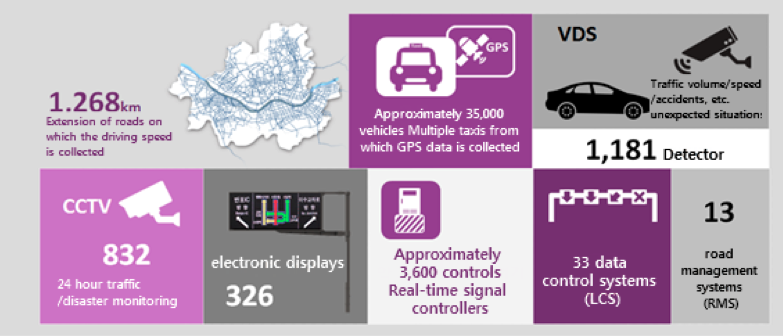
Source: Seoul Traffic Information Division (2016)
Fundamentally, the locational information of taxis equipped with GPS is collected in real time to calculate the speeds on roads. This is collected through wireless communication between the GPS fitted in standard vehicles, wireless communication devices, and roadside base stations.
Advanced on-site vehicle detection systems, such as loop detectors and video detectors, are installed at intervals of 250m to 500m on highways to collect the traffic speed and traffic volume information. Surveillance cameras allow the monitoring of communications and unexpected situations, and the road weather information system collects and provides climate information including conditions, temperature and visibility on the roads. In addition, information on traffic situations or unexpected situations is obtained from the National Police Agency, the Meteorological Administration, and citizen reports.
The road and traffic information collected through these channels is gathered at Seoul TOPIS, processed in real time, and then provided to traffic users in real time through diverse media channels such as mobile apps, ARS, navigation, SNS, the TOPIS website, road electronic displays, and traffic broadcasts.
In the event of an unexpected situation on the road, it is detected by a video or automatic detector and automatically displayed on an electronic display. The road control system controls and operates the roads according to the immediate needs, and provides information on bypass roads in order to regulate the flow of traffic. Furthermore, the connection road control system is operated according to the need to prevent any increase in traffic congestion, and the signal control system assists in smoothing the flow of traffic by prolonging the duration of green signals and lights on roads with severe congestion.
Seoul TOPIS also has the function of preparing for the full closure of a road due to an unexpected situation, such as a large-scale rally or bad weather, by carrying out various simulations.
Second, Seoul TOPIS manages approximately 9,000 Seoul buses in real time, and operates a public transportation information system that provides assistance with public transportation information to the users.
Bus-related information is collected in real time by installing bus information collection terminals that use the bus management systems (BMS) and traffic card functions mounted on all buses in Seoul. Through the combined terminals installed on 9,334 buses, all detailed information related to city buses is collected - including the operational status of all buses from the point of departure to the point of arrival; real-time speed; bus locations; sudden accelerations/stops; bypassing bus stops without stopping; route deviations; and driving with the door open. These bus information collection terminals also check traffic card information, and thus collect passenger information in real time. The terminals collect approximately 85 million items of traffic card information each day.
The collected information is provided to the public by automatically calculating bus arrival times and returning passengers using the Seoul TOPIS bus information processing technology. The bus operation management records (including various acts that may harm passenger safety) are systematically stored, analyzed and managed for use as an important index in the regular evaluation of bus corporations, and the bus routes are managed by adjusting unreasonable routes and constructing new routes to support the establishment of an optimal public transportation policy.
There are diverse means of providing bus information. First, bus information terminals (BIT) have been installed at 52% of Seoul’s bus stations to assist passengers with bus arrival times in real time and provide bus information, as well as subway arrival information. Bus passengers are provided with a wealth of information - such as the predicted bus arrival time, information related to buses for the disabled, the last bus of the day, congestion due to accidents, and the predicted time of arrival of the nearest subway - through the bus information terminals installed at these bus stations.
Furthermore, all information at Seoul TOPIS is 100% accessible by the public, and 24 million items of information are provided to the public through the open API method. Private corporations may reprocess this information to suit different types of consumers and to directly provide public transportation information to the users. Currently, a significant number of public transport users who use the Internet or smart phones receive public transportation information through the portals, websites or mobile applications of communications companies or through mobile apps launched by personal developers. As such, the users do not have to depend only on the bus information terminals installed at bus stations, but can plan their use of public transport anywhere, anytime.
All of this bus information, as well as the user-customized information (such as the safe arrival service which helps vulnerable pedestrians reach their destination via text, and an alarm function that notifies passengers of their arrival at the desired destination) can be provided on smart phones. Detailed information and websites can be obtained by accessing the QR code attached to individual bus stops, as well as by an automatic response service designed for bus passengers who are unfamiliar with smart phones.
The bus information collected and provided through such advanced devices displays a rate of accuracy of 98%. The accuracy of this information is amply demonstrated by the high usage rate of the combined public transportation information service, which surpassed 1.4 million hits, and a level of satisfaction of around 96%. Fig. 4 below displays the number and statistics related to the information collected at terminals by the public transportation information system.
Figure 5: Current status of Seoul TOPIS bus information system
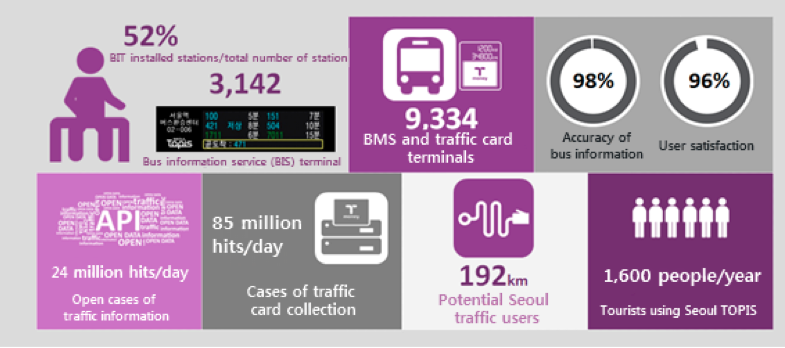
The electronic payment system, which allows passengers to pay for a variety of public transportation fares with a single card, is also linked with Seoul TOPIS. The bus information collection terminal explained above is constructed in such a way that it combines the bus operation information system with the traffic card system. The traffic card information collected thereby is becoming an important element of the public traffic information system of Seoul TOPIS.
Traffic cards are used by almost all public transportation users, including 100% of subway users and 98.7% of bus users. Taxi passengers are also displaying an increasing tendency to use traffic cards, with the figure currently standing at 53.5%.
Seoul’s combined electronic payment system follows the “distance proportion system” within the metropolitan area. In other words, a passenger who is travelling a distance within 10km can transfer to any other mode of public transport within a time limit of 30 minutes free of charge. The distribution of the fare is calculated based on the basic fare for each method of transportation.
The function of the traffic card has been expanded to include distribution, dining, culture, and traffic safety services, and thus is greatly extending the boundary of the electronic payment system; and payment can also be made via pre-paid card, credit card, or mobile phone. The traffic card was previously only available for use in Seoul, but its use is now permitted and functional in most regions of Korea. Elsewhere, the mobile payment compatibility service is also operated in Singapore, and there are plans to introduce the service to other countries including Japan, Hong Kong, Thailand, and Malaysia.
Seoul TOPIS controls illegally parked vehicles or vehicles stopped in bus lanes, thus causing traffic congestion, through the unmanned enforcement system.
In 2005, Seoul TOPIS began constructing and has since been operating an unmanned enforcement system which automatically controls illegally parked vehicles or vehicles stopped in bus lanes, and which is not dependent on any labor force.
Currently, the automatic unmanned enforcement system uses two types of devices: first, the fixed unmanned enforcement system installed on roads, which uses a detector to automatically control vehicles that are illegally parked or stopped or vehicles that drive in bus or bicycle lanes within 200m of the detection device; and, second, the portable unmanned enforcement system, which is simply a camera mounted on buses or monitoring vehicles that records the license plates of vehicles that violate the traffic code upon detection, and then transfers the information to Seoul TOPIS.
The fixed unmanned enforcement system is limited, however, in that it is unable to control vehicles committing violations outside its point of installation, whereas the portable unmanned enforcement system can eliminate this weakness as drivers are unaware of the point of installation.
Figure 6: Seoul TOPIS unmanned enforce system
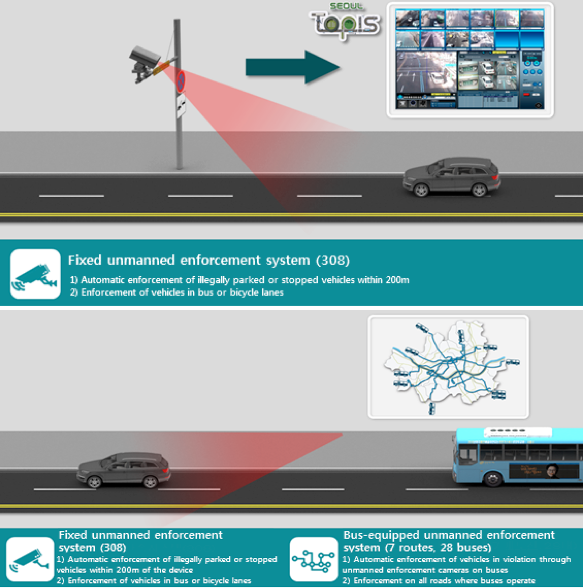
Source: Seoul Traffic Information Division (2016)
The unmanned enforcement system not only exposes vehicles committing violations, but is also the world’s first automatic penalty management system capable of automatically transferring a penalty notice to the owner of a vehicle in violation of the traffic regulations.
First, when the system detects a vehicle committing a violation, the registration plate of the vehicle is searched to automatically record the name of the owner and address of the vehicle. It then sends a penalty report containing photographic evidence and vehicle ownership information to the post office in electronic form. The electronic penalty notice is then automatically delivered to the address of the owner of the vehicle. All processes from the detection of a violation to the delivery of a penalty notice are performed automatically within just two to three days, which represents a great improvement upon the 10 to 15 days it usually took to complete the process prior to its successful automation. Thus, automation has evidently reduced the amount of labor and resources consumed by the process.
Figure 7: Seoul TOPIS automatic penalty imposition system
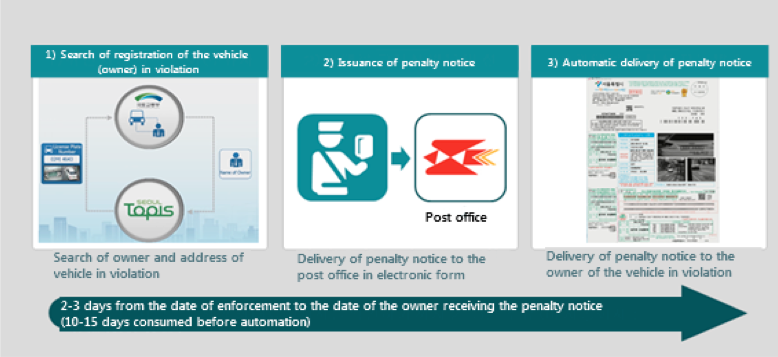
Source: Seoul Traffic Information Division (2016)
Seoul TOPIS operates 308 unmanned enforcement systems and controls approximately 1.8 million illegally parked or stopped vehicles as well as vehicles in bus lanes through this system.
Fourth, Seoul TOPIS is constructing and operating a traffic prediction system that prevents traffic congestion. Currently, traffic prediction is conducted on 157 km of highways, and is scheduled to expand to the main freeways.
In addition to these real-time traffic information services, the data related to the traffic flow on each road, weather, and accidents accumulated over the past five years is analyzed to predict the traffic situation on each road in 15-minute, 1-hour, and 1-day units. Furthermore, if or when an unexpected situation arises, such as an accident, traffic simulation is used to predict the outcome of the situation, and a congestion alarm is triggered to inform the driving public of both the regions and times of traffic congestion in advance, thereby helping drivers to avoid using certain roads at certain times as well as providing other important benefits.
The traffic prediction technology, which was developed by the Korea Transport Institute, shows a verified prediction accuracy of 90% on urban highways. Seoul TOPIS intends to expand the traffic prediction system to the main roads of Seoul to allow citizens to use traffic predictions in a similar way to how they use weather forecasts in everyday life.
Furthermore, the traffic prediction system can be used to prevent potential accidents based on communication between vehicles, i.e. the V2V technology and bilateral wireless communication can be used between a vehicle and communication-based infrastructure (V2I) to provide roadside assistance reflecting real-time road situations, signal changes, and the prediction of crosswalk locations.
Seoul TOPIS: Organization and Operation
Seoul TOPIS is an organization that plans, constructs, and operates the intelligent traffic system, and is composed of 32 public servants in four divisions. Seoul TOPIS has a total of 150 employees who are dedicated to monitoring, controlling, maintaining and managing the traffic situation.
The operation of Seoul TOPIS requires an annual budget of KRW 17 trillion, most of which is used for site facilities and for maintenance and management of the labor force.
Fig. 8 below provides a summary of the statistics related to the operation of Seoul TOPIS, the unmanned enforcement system and other related aspects.
Figure 8: Seoul TOPIS organization and operation, and other related statistics
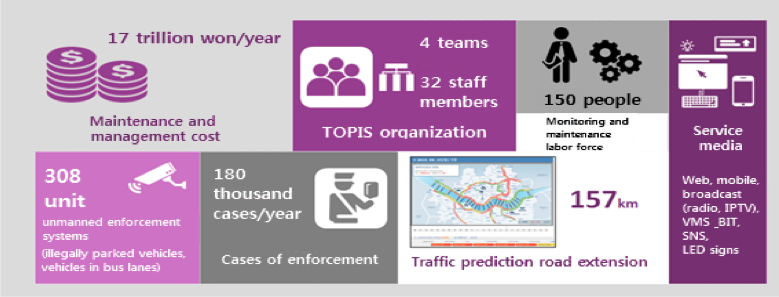
Source: Seoul Traffic Information Division (2016)
Technical Details
1) Main system of Seoul TOPIS
The central system, which is equivalent to the brain of TOPIS, collects, combines and processes all the information in real time and then enables an immediate response by providing information to the operator.
The operator is supported and able to control all traffic and disaster situations from the center by providing the necessary information to citizens and taking all the appropriate precautions – such as detecting the symptoms of unexpected situations and disasters by monitoring all information, and controlling on-site equipment such as traffic signals and electronic displays. Furthermore, the system is constructed so as to allow rapid contact and cooperation with the related organizations.
Figure 9: Seoul TOPIS center system
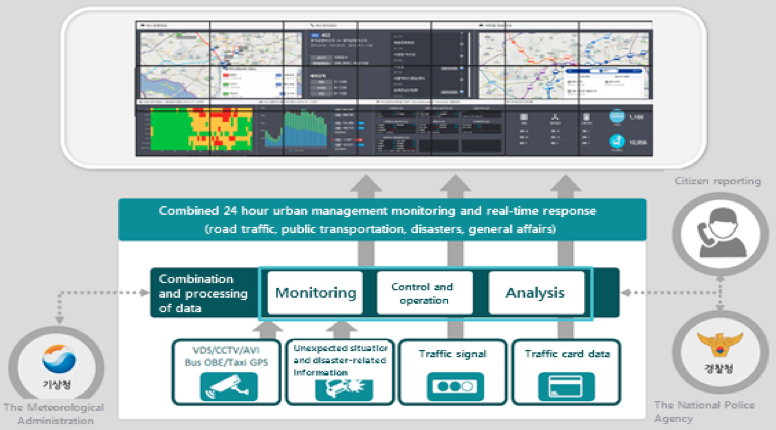
Source: Seoul Traffic Information Division (2016)
2) Bus Information System
Figure 10: Seoul TOPIS bus information system

Source: Seoul Traffic Information Division (2016)
Operation of all 9334 buses in Seoul, from the point of departure and arrival, is collected in real-time through the Seoul TOPIS bus information system. Each bus has an integrated bus terminal installed therein combining bus operation information and the traffic card function. It collects all bus-related information, such as the passengers and running of the bus (including factors such as sudden accelerations, sudden stops, and nonstop passing) in addition to real-time speeds and locations.
The collected information is provided to the citizens by automatically calculating the number of returning passengers and the arrival time of buses based on the Seoul TOPIS bus processing technology. From this, various actions that may cause harm to the safety of citizens are stored and analyzed for use in the evaluation of bus corporations.
Bus Management System (BMS)
Bus Information System (BIS)
3) Unmanned enforcement system
The unmanned enforcement cameras cover all vehicles within a 200m radius in all directions on all roads. Vehicles captured by the unmanned enforcement camera are confirmed in as little as five minutes.
Portable or bus-equipped unmanned enforcement systems have the advantage of detecting vehicles on all roads of the pertinent route. Of the four cameras equipped on buses, two cameras equipped at a 45 degree angle detect illegally parked vehicles on the shoulder of the road.
Currently, fixed enforcement cameras are installed in all regions of Seoul, and the bus-equipped cameras are able to detect vehicles on main freeways in real-time.
Enforcement can also be confirmed by the public in real-time.
When a search is performed on the owner of the vehicle and the penalty is imposed using the number plate and photograph sent to the traffic violation management system, the notice is printed and sent to the post office. Here, it is automatically connected to the nearest post office of the owner of the vehicle and duly sent out.
All phases of Seoul’s unmanned enforcement system are automatically performed, from the enforcement to the receipt of the penalty.
A sum of approximately 120 billion won, from 3 million cases of enforcement each year, is used for the maintenance and operation of public parking lots. Accordingly, the unmanned enforcement system contributes to the relief of urban traffic congestion as well as a lack of parking spaces.
Policy Effects
Figure 11: Current status of Seoul TOPIS information in use
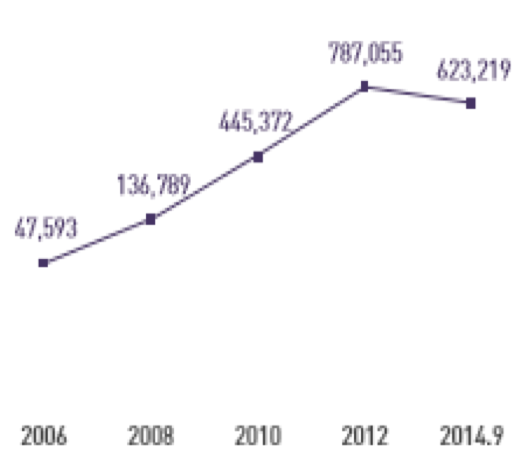
Source: Seoul Traffic Information Division (2016)
Traffic cards are used by almost all public transportation users, including 100% of subway users and 98.7% of bus users. Taxi passengers are also displaying an increasing tendency to use traffic cards, with the figure currently standing at 59%. (Seoul Urban Traffic Division 2016)
Increase in the Bus Allocation Rate
| 2004 | 2005 | 2006 | 2007 | 2008 | 2009 | 2010 | |
| Subway | 4,567 | 4,540 | 4,533 | 4,532 | 4,577 | 4,730 | 4,835 |
| Bus | 4,782 | 5,451 | 5,662 | 5,603 | 5,647 | 5,681 | 5,719 |
| Total | 9,349 | 9,991 | 10,195 | 10,135 | 10,224 | 10,411 | 10,554 |
- 4.6% increase in the accuracy of bus arrival times (from 87.3% in 2006 to 91.4% in 2013)
- 26% increase in the average speed of buses (15 km/h to 19 km/h)
- 2.6% increase in the average daily No. of bus passengers (increase of 150,000 passengers, from 5.6 million/day in 2007 to 5.75 million/day in 2013)
Challenges and Solutions
At the time of policy implementation, there was an increase in the general understanding of, and interest in, the ITS due to the national introduction of the ITS project. With respect to the policy plan and implementation process, there were no obstacles or technical difficulties related to those interest groups which may be regarded as the direct beneficiaries, i.e. Seoul City, bus companies, drivers, and bus passengers.
Reference
- TOPIS https://seoulsolution.kr/content/%EC%84%9C%EC%9A%B8%EA%B5%90%ED%86%B5%EC%A0%95%EB%B3%B4%EC%84%BC%ED%84%B0topis
- Pucher, J., H. Park, M. Han Kim and J. Song (2005) ‘Public transport reforms in Seoul: Innovations motivated by funding crisis’, Journal of Public Transportation 8 (5):41–62
- Park, Y-W (2010) ‘BRT system in Seoul and integrated e-ticketing’, UITP Asia Pacific Symposium on Public Transport (with special focus on BRT), 20–21 January, Delhi
- Cited in Heather Allen(2013) Global Report on Human Settlements 2013 (Available from http://www.unhabitat.org/grhs/2013)
- Seo, B. M., Cho, J. S. (2012) Seoul Bus Information System (BIS) Case Study: Focused on the Analysis of the Effect from the User’s Perspective, Global Management Study Vol. 24, No. 2, p.29-52.
- Seoul Statistics http://stat.seoul.go.kr/jsp3/index.jsp (searched on August 23, 2016)
- Seoul Traffic Information Division (2016) Seoul TOPIS Presentation
- Seoul Urban Traffic Division (as of 2016) People-prioritized safe and convenient traffic
